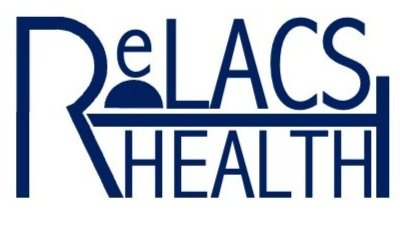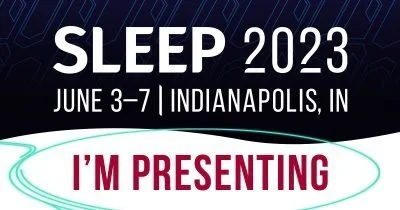8 Interesting Things from SLEEP 2023: A ReLACSing Blog #27
Returning this week from the beautiful weather in Indianapolis, which hosted the Associated Professional Sleep Societies’ (APSS) annual conference, SLEEP 2023, I will review a handful of topics I found interesting from this year’s largest national meeting on sleep and circadian rhythms.
1) Not to start with a downer, but the Program Committee of APSS continued to support my contention that restless legs syndrome (RLS) is the red-headed stepchild of sleep medicine. RLS garnered a whopping 25-minute lecture by Dr. John Winkelman within a medication management session and…not…one…additional minute of stage time in the Scientific Program’s General Sessions. Again, this is a condition that significantly affects roughly 2.5% of the US population and is the third or fourth most common sleep condition. As a comparison, there was no shortage of talks and presentations on narcolepsy type 1, which has a prevalence of 0.025%. The latter condition has diagnostic sleep testing that brings in considerable insurance revenue, and there is an army of drug companies advertising and promoting new drugs for narcolepsy. Money talks. There were more than a half-dozen RLS poster abstracts, none of which was selected for presentation in a conference lacking any dedicated oral presentation section for RLS. I’ll nevertheless summarize a few of the interesting abstracts a little later.
2) Let’s begin with the keynote address of the Plenary Session. Phyllis Zee, MD, PhD of Northwestern gave a wonderful overview of the complex triangular relationship among the body’s central timekeeping clock, which resides in the suprachiasmatic nucleus of the brain, the peripheral clocks that have their own timekeeping processes throughout different parts of the body like the liver and stomach, and the environment that influences both clocks such as sunlight and meals. She highlighted the importance of developing testing methods widely available to clinicians to help with biological clock disorders. These are under-appreciated in the clinical sleep field, in my view, partly due to lack of objective testing. For example, there is a condition called delayed sleep-wake phase disorder in which an individual prefers to fall asleep and wake up much later than the average person and is off-cycle from the light and dark cycles of the day. Dr. Zee pointed out that half of patients we diagnose with this condition do not have an objectively delayed dim light melatonin onset (DLMO), which can be obtained through testing melatonin in one’s saliva, but it is not commercially available currently. Knowledge of DLMO would change the one-size-fits-all approach to this condition depending on the actual DLMO when it comes to administering light exposure and melatonin supplements along with devising a sleep schedule strategy.
3) Kenneth Wright, PhD of the University of Colorado gave one of many talks on the influences of artificial light on sleep and biological clocks in our industrial societies. He said that if our human evolution was the equivalent of a 24-hour day, then artificial light has been around for 1 second! For us indoor people, we are getting way too much light at night and after sunset and too little during the day. We have not evolved for this discrepancy of light exposure. Dr. Wright was part of a group of researchers from a diverse set of fields that recently provided recommendations for lighting. They advocated for the use of the melanopic equivalent daylight luminescence (EDI), which is easily measured. During the daytime, we should get > 250 EDI, < 10 EDI at night, and < 1 EDI while sleeping. As a comparison, I’m probably writing this to you during the day in < 150 EDI. It seems that we all need to brighten our days and put the darkness back into the night!
4) In the realm of chronic insomnia, or difficulty falling asleep or maintaining sleep throughout the night, Julia Boyle, PsyD of the New England Geriatric Research Education and Clinical Center presented an interesting study on the time course of the severity of insomnia symptoms. There have been competing beliefs that insomnia affects individuals the most at the beginning (3P model) whereas another (4P model) posits that insomnia progressively worsens as it becomes a chronic condition. This study looked at 800+ subjects and found that “the worst is first” as those who developed acute insomnia had worsening over the first two weeks and then aspects of sleep remained stable over several weeks and months if the condition became chronic. Most of the worsening was in the amount of time they were awake after they initially fell asleep. One biological explanation is that insomnia may be caused by more epinephrine and norepinephrine (“fight or flight” neurotransmitters) in the first several days. Think of the “adrenaline” surge if one lost their job or had a sudden death of a close relative. These chemicals would affect sleep in the immediate days thereafter. In chronic insomnia, the GABA system that promotes sleep goes down and the hypocretin and glutamate systems, which promote being awake, may become stronger, but these effects are not as disruptive to sleep as the fight or flight hormones at the beginning.
5a) The timing of meals and its relationship to the biological clock remains a hot topic. In a small study of time-restricted eating (TRE) by graduate student Catherine Lowry of Colorado State, a group of healthy individuals who consumed the same amount of calories for one week at their usual eating times were switched in the second week to TRE, consuming all their food within an 8-hour window with 16 hours of fasting in between. Levels of the satiety hormone leptin and a measurement called the respiratory exchange ratio both decreased suggesting increased fat oxidation (more fat burn!) from restricting the eating time window without changing the amount of calories.
5b) Daisy Duan, MD of Johns Hopkins studied a group of obese, predominantly African American women and the effect of TRE with a 10-hour eating window to examine the effects on sleep. Her study found that the TRE group went to bed earlier and got more sleep than the group that ate at their habitual times. It suggests that TRE could have a positive effect on the biological clock and sleep, though the researchers were unsure if the results were actually due to TRE inducing a social change. For example, TRE could have prevented the subjects from going out for a late night snack, and the reduced social activity led to an earlier bedtime. There were quite a few abstracts and presentations mostly supporting the idea that we should eat food within a narrower range of time for health reasons (like we used to > 75 years ago when most of us had a normal body mass!).
6) OK, after throwing the red flag on the Program Committee of APSS for ignoring RLS, I probably should stop ignoring RLS myself, and talk about a couple of abstracts that were not formally presented. The biggest breakthrough in my view is the neurostimulation device by Noctrix Health. A non-medication treatment for RLS has been highly sought after by patients and clinicians alike, and we may have finally found one with excellent clinical trial results. Noctrix Health has developed a non-invasive peroneal nerve stimulator device that patients can wear around their legs just below the knee and turn it on to provide stimulation to the nerve running along the outside of the knee. The idea would be providing positive feedback to the brain, similar to walking for example, to help shut off the bothersome symptoms of RLS that tend to occur at nighttime. They studied subjects with rather severe RLS and demonstrated significant improvements in symptoms for greater than 24 weeks with a separate analysis highlighting the improvements to quality of life and healthcare utilization from RLS relief. Here is a recently published larger study of 20 patients over 14 days to use the stimulator.
7) For a few small bites of some of the other RLS abstracts:
Champion et al. showed that the painful variant(s) of RLS was more associated with other chronic pain conditions whereas the traditional painless variant(s) of RLS was more associated with iron deficiency.
Cederberg et al. found that exercise generally improved RLS symptoms, but abrupt changes in the nature of exercise or working out closer to nighttime may be associated with worsening symptoms of RLS.
Zackon and Winkelman looked at the National RLS Opioid Registry for suicidal thoughts in relationship to severe RLS, augmentation, and opioid treatment. They found this symptom to be highly prevalent but it improved over time with better control of RLS symptoms, anxiety, depression, and opioid stigma. Methadone stood out as being associated with less suicidal thinking, which was linked to better control of RLS symptoms in this study.
Carvalho et al. presented a case study of a patient’s RLS improving dramatically after obtaining a spinal cord stimulator for other pain conditions. The group found 16 other patients reported in the literature with improvement to RLS from spinal cord stimulation. This type of treatment may warrant formal study in RLS.
8) Lastly, yours truly presented a poster on the long-term effectiveness of buprenorphine for treatment of severe RLS, which I had previously referenced in this video. We followed 55 patients for up to 21 months, which is the second largest long-term study of opioids for RLS behind a randomized, controlled trial of oxycodone-naloxone a few years ago. The results showed that 76% remained on buprenorphine at their final visit and there was dramatic improvement not only to RLS severity, but also measures of sleepiness, insomnia, mood, and sleep quality over the course of the study beyond one year. Most patients with dopaminergic augmentation were able to wean completely off their dopamine agonist while the remaining were able to taper to a reduced dose on their way to being dopaminergic medication-free. Hopefully, we can publish the full study in the next year, which will help to promote a safer opioid option amidst an anti-opioid culture. It could also provide support for insurance coverage for this medication, which is already in wide use among RLS specialists but off the radar for those organizations that hold the purse strings.
-Andy Berkowski, MD of ReLACS Health, who found another thing lacking at SLEEP 2023 besides presentations on RLS: time to sleep

